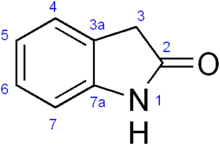 | |
 | |
| Names | |
|---|---|
| Preferred IUPAC name
1,3-Dihydro-2H-indol-2-one | |
| Identifiers | |
3D model (JSmol) |
|
| 114692 | |
| ChEBI | |
| ChEMBL | |
| ChemSpider | |
| ECHA InfoCard | 100.000.390 |
| EC Number |
|
| 637057 | |
| KEGG | |
| MeSH | Oxindole |
PubChem CID |
|
| RTECS number |
|
| UNII | |
CompTox Dashboard (EPA) |
|
| |
| |
| Properties | |
| C8H7NO | |
| Molar mass | 133.150 g·mol−1 |
| Appearance | pale yellow solid |
| Melting point | 128 °C (262 °F; 401 K) |
Except where otherwise noted, data are given for materials in their standard state (at 25 °C [77 °F], 100 kPa).
Infobox references | |
Oxindole (2-indolone) is an aromatic heterocyclic organic compound with the formula C6H4CHC(O)NH. It has a bicyclic structure, consisting of a six-membered benzene ring fused to a five-membered nitrogen-containing ring. Oxindole is a modified indoline with a substituted carbonyl at the second position of the 5-member indoline ring. Classified as a cyclic amide, it is a pale yellow solid.
Formation and reactions
Oxindole is derived in nature from tryptophan, formed by gut bacteria ("normal flora"). It is normally metabolized and detoxified from the body by the liver. In excess, it can cause sedation, muscle weakness, hypotension, and coma. Patients with hepatic encephalopathy have been recorded to have elevated serum oxindole levels.[1]
Treatment with phosphorus pentasulfide gives the thione.
Oxindoles

Beyond, the parent compound, oxindoles include many compounds.[3] One example is 3-methyloxindole.[4]
References
- ↑ Riggio, Oliviero; Mannaioni, Guido; Ridola, Lorenzo; Angeloni, Stefania; Merli, Manuela; Carlà, Vincenzo; Salvatori, Filippo Maria; Moroni, Flavio (2 February 2010). "Peripheral and Splanchnic Indole and Oxindole Levels in Cirrhotic Patients: A Study on the Pathophysiology of Hepatic Encephalopathy". The American Journal of Gastroenterology. 105 (6): 1374–1381. doi:10.1038/ajg.2009.738. PMID 20125128. S2CID 20633097.
- ↑ Kang TH, Murakami Y, Matsumoto K, Takayama H, Kitajima M, Aimi N, Watanabe H (2002). "Rhynchophylline and Isorhynchophylline Inhibit NMDA Receptors Expressed in Xenopus Oocytes". European Journal of Pharmacology. 455 (1): 27–34. doi:10.1016/S0014-2999(02)02581-5. PMID 12433591.
- ↑ Trost, Barry; Brennan, Megan (2009). "Asymmetric Syntheses of Oxindole and Indole Spirocyclic Alkaloid Natural Products". Synthesis. 2009 (18): 3003–3025. doi:10.1055/s-0029-1216975.
- ↑ Abraham S. Endler and Ernest I. Becker (1957). "3-Methyloxindole". Org. Synth. 37: 60. doi:10.15227/orgsyn.037.0060.